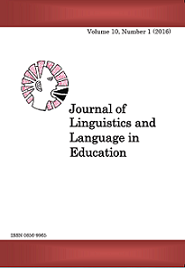A Descriptive Study of Kiswahili as a Foreign Language Learners ' Motivations: HUFS Case Study
Abstract
This study is a descriptive account of 40 Kiswahili as Foreign Language (KFL)students of Hankuk University of Foreign Studies in South Korea of the
2009/2010 academic year. A questionnaire was administered to these
students, after they agreed to take part in the study. The study is guided by
Cohen and Dörnyei ' s (2002) process motivations and by Brown ' s (1981)
traditional intrinsic and extrinsic motivations. The findings indicate that the
students were variously motivated, although there was predominance of
actional motivations over pre- and post-actional ones. Moreover, the majority
of students were intrinsically motivated to learn KFL mainly within the global
motivation framework, and others were integratively and instrumentally
motivated. It was concluded that, given the dynamic nature of leaner
motivations, the role of a foreign language teacher is sustaining and,
whenever possible, strengthening such motivations.
References
Agnihotri, R.K., & A.L. Khanna. (1994). Second Language Acquisition: Socio-cultural and
Linguistic Aspects of English in India. New Delhi: Sage.
Brown, D.E. (1991). Human Universals. New York: McGraw-Hill.
Brown, H.D. (1981a). Second Language Acquisition/Learning: Psycholinguistic Factors.
In R. B. Kaplan, et al. (eds.), Annual Review of Applied Linguistics 1: 108-113.
Brown, H.D. (1981b). Affective Factors in Second Language Learning. In J. E. Alatis, H.
B. Altman and P. M. Alatis (eds.), The Second Language Classroom: Directions for
the Eighties. New York: Oxford University Press.
Brown, H.D. (1994). Principles of Language Learning and Teaching. 3rd Edition.
Englewood Cliffs NJ: Prentice-Hall.
Cohen, A.D., & Z. Dörnyei, (2002). Focus on the Language Learner: Motivation, Styles
and Strategies. In N. Schmitt (ed.), An Introduction to Applied Linguistics. London:
Arnold.
Crookes, G. (2003). A Practicum in TESOL: Professional Development through Teaching
Practice. Cambridge: Cambridge University Press.
Crystal, D. (2003). A Dictionary of Linguistics and Phonetics. 5th Edition. London:
Blackwell.
Deci, E. L. and Ryan, R. M. (1985). Intrinsic Motivation and Self Determination in
Human Behaviour. New York: Plenum Publishing Corporation.
Dörnyei, Z. (1994). Understanding L2 Motivation: On with the Challenge! The Modern
Language Journal 78(4): 515-522.
Dörnyei, Z. (1998). Motivation in Second and Foreign Language Learning.
LanguageTeaching 31:117-135.
Dörnyei, Z. (2001). Teaching and Researching Motivation. England: Pearson Education
Limited.
FLE Boot Camp. (2008). Student Motivations in EFL. Retrieved September 9th 2010
from http://teflbootcamp.com/tefl-skills/
Gardner, R.C., & Lambert, W.E. (1972). Attitudes and Motivation in Second Language
Learning. Rowley, Massachussets: Newbury House.
Gardner, R.C. (2001). Language Learning Motivation: The Student, the Teacher and the
Researcher. Texas Papers in Foreign Language Education 6:1-18.
Harter, S., & J.P. Connell. (1984). A Model of Children ' s Achievement and Related Self-
Perceptions of Competence, Control and Motivational Orientation. In J.G. Nicholls
(ed.), Advances in Motivation and Achievement. London: JAI Press Inc.
Herald, K. (2012). HUFS steps up push for globalization. http://www.koreaherald.com/
national/ Detail.jsp, accessed 4th October, 2012.
Jack, R. (1992). Longman Dictionary of Language Teaching and Applied Linguistics.
London: Addison Wesley Publishing Company.
Kambon, O. (2005). Theory of Intrinsic and Extrinsic Motivation in Interlanguage
Development and Fossilization of Errors. Retrieved October 13, 2010 from
www.abibitumikasa.com/.../36470-theory-intrinsic-motivation-fossilization-errorlanguage-
learning.html
Kelly, C. (n.d.). A Review of Traditional and Current Theories of Motivation in ESL.
Retrieved October 5, 2010 from http://www.osaka-gu.ac.jp/php/kelly/papers/
motivation.html
Pintrich, P. (2000). The Role of Goal Orientation in Self-regulated Learning. In M.
Boekarts, P. Pintrich and M. Zeidner (eds.), Handbook of Self Regulation. Sydney:
Academic Press.
Richards, J.C., & R. Schmidt, (2002). Longman Dictionary of Language Teaching and
Applied Linguistics. 3rd Edition. London: Longman.
Skehan, P. (1989). Individual Differences in Second Language Learning. London:
Edward Arnold.
Williams, M. (1994). Motivation in Foreign and Second Language Learning: An
Interactive Perspective. Educational and Child Psychology 11(2): 77-84.
Published
Issue
Section
License
Copyright © by Department of Foreign Languages and Linguistics, University of Dar es Salaam
All rights reserved. No part of this publication may be reproduced or transmitted in any form or by any means, electronic or mechanical, including photocopying, recording, or any information storage or retrieval system, without permission in writing from the publisher, except for short extracts in fair dealing, for research or private study, critical scholarly review or discourse with an acknowledgement.


